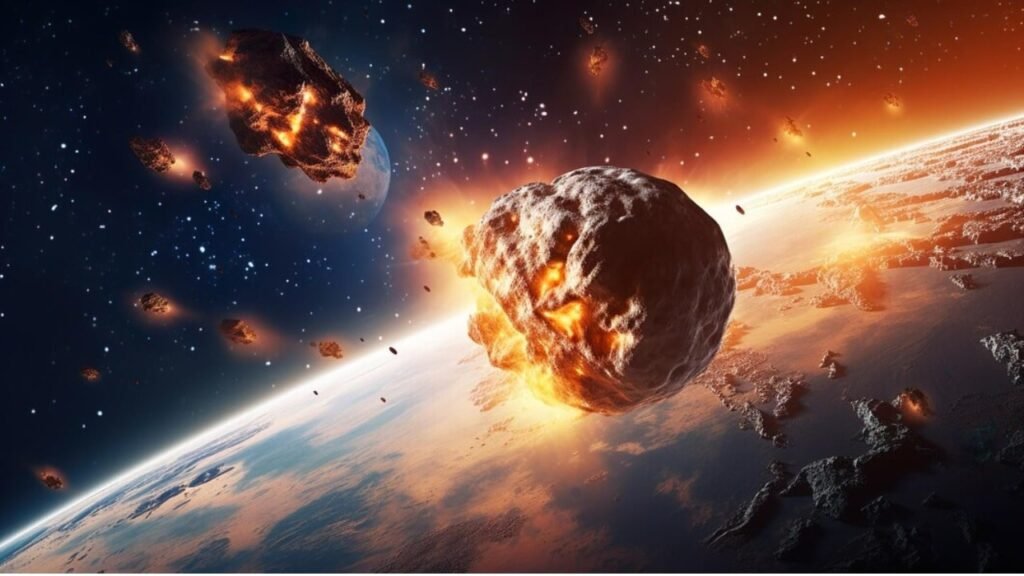A recent NASA exercise that modeled a fictitious asteroid impact scenario indicated that there is a 72% likelihood that Earth will collide with a planet-sized asteroid in 2038. Despite a 14-year warning, the experiment demonstrated worldwide unpreparedness and difficulty in detecting and deflecting asteroids.

In an eye-opening revelation, NASA recently disclosed the results of a hypothetical exercise that projected a significant planet-sized asteroid impact on Earth with a 72% probability by the year 2038. This simulation, conducted during the fifth biennial Planetary Defense Interagency Tabletop Exercise, highlighted the urgent need for enhanced planetary defense measures. Despite a 14-year lead time, the exercise underscored global unpreparedness to effectively tackle such a catastrophic event.
Held in April at the Johns Hopkins Applied Physics Laboratory in Laurel, Maryland, the exercise brought together nearly 100 representatives from various US government agencies and international collaborators. Organized by NASA’s Planetary Defense Coordination Office (PDCO) in partnership with FEMA and the US Department of State Office of Space Affairs, the simulation aimed to assess the readiness of national and global responses to a hazardous asteroid threat.
Scenario Overview
Participants were confronted with a challenging scenario: a never-before-detected asteroid was identified with an initial calculation indicating a 72% chance of impacting Earth in approximately 14 years. Complicating matters, essential follow-up observations were delayed for seven months due to the asteroid’s position behind the Sun, making it difficult to precisely determine its size, composition, and long-term trajectory.
The preliminary observations during the exercise were insufficient to ascertain the asteroid’s exact dimensions and characteristics. This lack of precise data is critical, as understanding an asteroid’s size and composition is crucial for developing effective deflection or disruption strategies. The exercise revealed significant gaps in our current capabilities to respond to such a threat, despite the extended warning period.
Technological and Strategic Challenges
- Deflection and Disruption Technologies:
- Current technologies, such as kinetic impactors or nuclear devices, require years of development and rigorous testing. The exercise highlighted the limited capability to deflect or disrupt an asteroid on short notice. The successful impact of NASA’s DART (Double Asteroid Redirection Test) mission on the asteroid moonlet Dimorphos in 2022 demonstrated the potential of using a kinetic impactor to alter an asteroid’s path. However, scaling this up for a larger asteroid poses significant challenges.
- Detection and Monitoring:
- The seven-month observational gap due to the asteroid’s position behind the Sun emphasized the need for continuous and comprehensive monitoring of near-Earth objects (NEOs). NASA’s upcoming NEO Surveyor, an infrared space telescope designed to detect and characterize potentially hazardous NEOs long before they pose a threat, is slated for launch in June 2028. This tool will significantly enhance our detection capabilities.
- International Collaboration:
- An asteroid impact would have global consequences, making international cooperation crucial. The exercise underscored the importance of collaboration among nations to develop and implement effective planetary defense strategies.

The Role of NASA’s Planetary Defense Coordination Office
Established in 2016, NASA’s PDCO leads the agency’s efforts to monitor and address potential asteroid threats. The office is responsible for detecting, tracking, and characterizing NEOs and developing strategies to mitigate their impact hazards. The Sentry impact-monitoring system regularly evaluates prospective impact threats by conducting long-term studies of potentially dangerous asteroids’ future orbits.
Insights and Recommendations from the Exercise
- Strengthening Detection Systems:
- Investing in advanced detection systems, like the NEO Surveyor, is crucial. Early and accurate detection allows for timely intervention strategies to be developed and implemented.
- Enhancing Deflection Technologies:
- Continued research and development of deflection technologies, including kinetic impactors and nuclear options, are necessary. These technologies need to be tested and refined to ensure their viability in real-world scenarios.
- Promoting International Collaboration:
- Establishing robust international partnerships is essential for coordinated response efforts. Sharing data, resources, and expertise will enhance global preparedness for potential asteroid impacts.
- Public Awareness and Preparedness:
- Raising public awareness about the potential risks and preparedness measures is important. Educating communities on what to expect and how to respond in the event of an asteroid threat can mitigate panic and ensure a more organized response.
Conclusion: A Wake-Up Call for Global Preparedness
The hypothetical exercise conducted by NASA serves as a crucial wake-up call for the global community. While there are no known significant asteroid impact threats for the foreseeable future, the exercise highlights the importance of being proactive in our planetary defense efforts. The potential for a catastrophic asteroid impact, though infrequent, is real and requires immediate attention to develop effective detection, deflection, and international collaboration strategies.
By investing in advanced technologies and fostering global cooperation, we can enhance our readiness to protect Earth from celestial hazards. The time to act is now, ensuring that we are better prepared to face potential asteroid threats in the future.
Read Next:

The Psychology of Love: Why Valentines Day Matters More Epic Than You Think
Discover the psychology of love and why Valentines Day is more important than you think. Learn how love impacts the brain, strengthens relationships, and boosts

Premier League Highlights: Arsenal Humiliate Man City 5-1, Spurs and Palace Secure Crucial Wins
Arsenal demolished Manchester City 5-1 in a statement premier league highlights win, reigniting their title hopes. Meanwhile, Crystal Palace stunned Man United 2-0, and Tottenham

How Budget 2025 Impacts the Indian Middle-Class: Major Tax Benefits and Glaring Omissions
Budget 2025 offers major tax relief to the middle class, including zero tax on incomes up to ₹12 lakh. However, it misses out on incentives
